A dairy-free take on the easiest of pies – the rustic galette! This one has an orange scented flaky olive oil crust with a pear and sage filling to highlight the best in fall flavours. Today’s Dash of Science: Saturated versus unsaturated fats and how to use them in pastry.
Galettes are probably my favourite style of pie to make. They keep everything so simple with a single crust that is simply folded over the fruit at the edges. No crimping, no special dishes, just crust-fruit-fold-done. You can even make a savoury galette with vegetables. 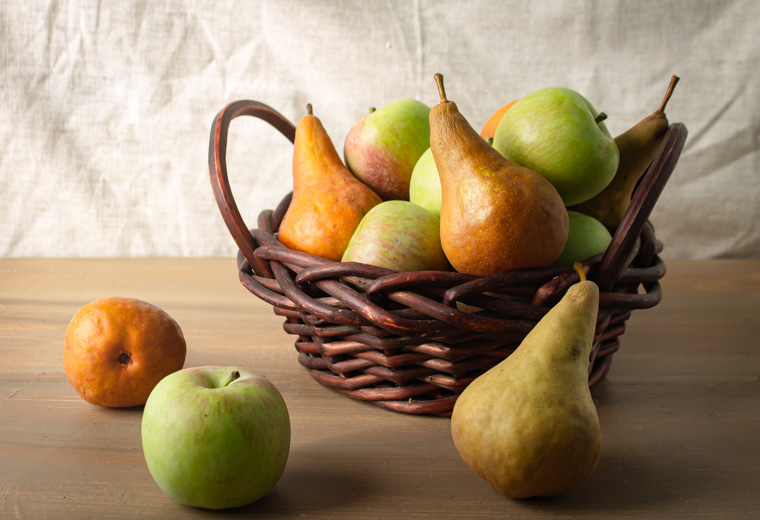
When I am making a fast fruit dessert galette I will typically use a butter-based pie crust and no egg wash just to keep everything really easy. It’s a great solution for “I forgot I was supposed to make dessert”. Use any fruit – plus a bit of flour to thicken (you don’t even need sugar most of the time) – and perhaps a squeeze of lemon juice. And if it doesn’t look picture perfect? It’s “rustic”. 
Admittedly, this version is a little more involved. Not any harder if you go for the rustic look (I did the fancy one for another cooking contest – I won!), just more ingredients and a slightly different technique for working with the olive oil crust.
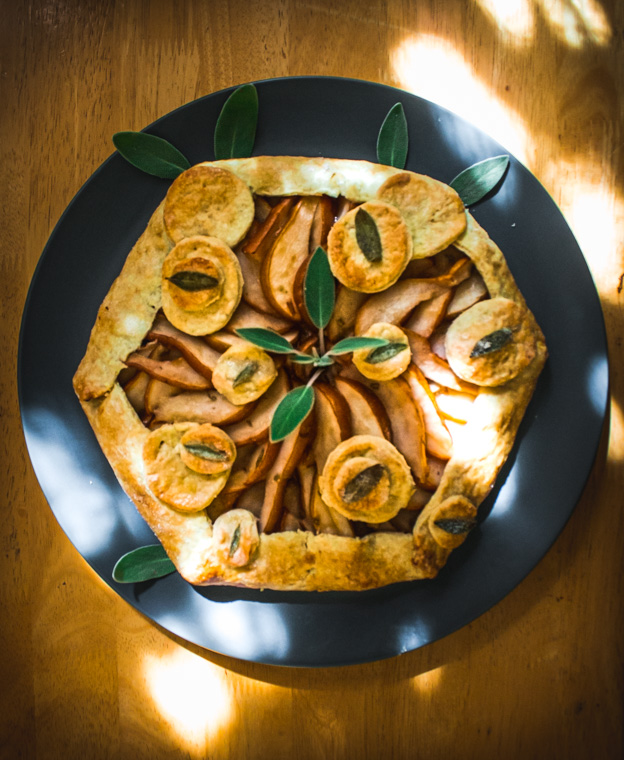
A Dash of Science
Using oil as your fat in a pastry is different than using a – I’m going to use a bad word here – saturated fat. So let’s start with the actual difference between saturated and unsaturated fats.
Unsaturated Fat vs. Saturated Fat
From the most basic standpoint, a saturated fat is solid at room temperature (defined scientifically as 75F/25C) while an unsaturated fat is liquid. Typically, saturated fats come from animal sources while unsaturated fats are vegetable based. This is why saturated fats are considered “bad”. Because they come from animals, there are also some cholesterol molecules mixed in (and saturated fats tend to increase cholesterol production in the body). Like too much of anything, too much cholesterol is unhealthy, but some is just fine and makes the world taste better.
The simplest explanation (without going too much into molecular bonds forming and breaking, I’ll leave that to Food Crumbles as usual) is that saturated fats have water as part of their molecular structure. For most pastries, this water is what creates the flakiness. Think about the names – saturated vs unsaturated – is it wet or not? It’s all about water!
“But my olive oil is solid after it comes out of the fridge, does that mean it got saturated?”
No. Olive oil has a much higher “freezing point” (the point at which it turns into a solid) than most vegetable oils. Saturation describes the molecular component which do not change when cold. And your fridge is definitely not room temperature unless you are doing something very wrong (or live where it is very cold without a heating system). If you are really worried, just wait for the olive oil to warm up again.
Hydrogenated Oils
You may be thinking “but vegetable shortening is vegan and solid at room temperature” – well, yes, but that is because of processing. Like olive oil, simply chilling (or whipping) vegetable oils will not make them stay solid at room temperature. But what the processing mechanism does is artificially change the molecular structure (adding hydrogen atoms, hence hydrogenated) so that steam can be created during the baking process. It is still fairly hotly debated whether hydrogenated vegetable oils are better or worse for you than naturally saturated fats (a layman friendly article from Harvard or a couple of studies here and here). The only definitive is that trans fats (or trans fatty acids) created in the processing of hydrogenated fats in the earlier 20th century are very bad.
Moral of the story: Too much fat is bad, but a little bit won’t kill you so you might as well enjoy your food.
Using Oil in Place of Butter in Pastry
Now that we have all the definitions and health aspects out of the way, there are differences when working with oil as your fat in pastry.
- It doesn’t have that nice molecular structure that creates lots of steam as it is heated. For a proper flaky pastry we need to compensate.
- It adds more liquid to your dough. So there is the risk of your dough becoming very difficult to work with. Particularly because a liquid oil is going to interfere with gluten bonds even more than solid fats – so we need to add more water.
Replacing butter in a recipe with oil in a one to one ratio is not going to yield a good result. So the best solution is to reduce the oil, add a bit more water, and help the rise with just a smidge of baking powder. The dough is still a little wetter than a standard butter crust, but rolling it between parchment paper solves that.
Then you get a wonderfully flaky dairy-free olive oil crust that you could also use in a pie pan!
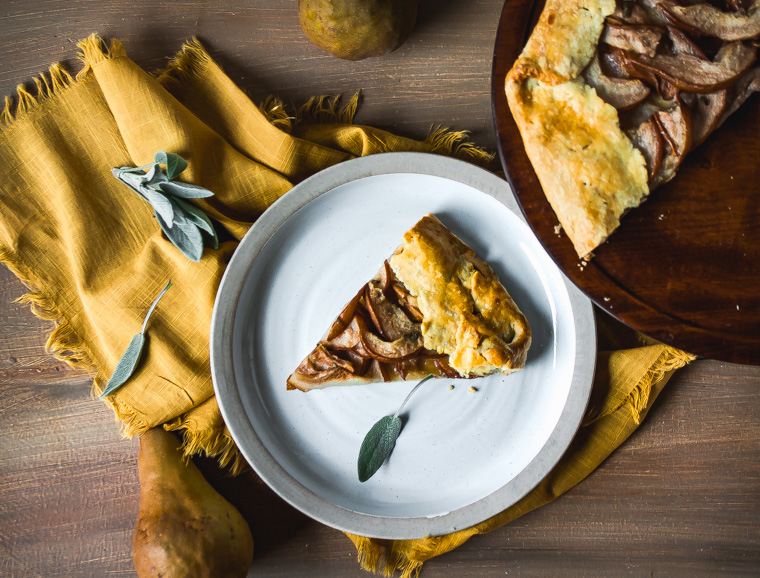
Pear Sage Galette with an Olive Oil Crust
Ingredients
Crust:
- 1 ½ c/180g all-purpose flour
- 2 tbs/25g granulated sugar
- 1 tsp/4g baking powder
- 1/8 tsp salt
- 3 tbs/45ml orange flavoured olive oil* Sepay Groves Blood Orange
- 3 tbs/45ml pungent olive oil Il Fiorello Taggiesca
- 4 ½ tbs/67ml cold water
Filling:
- 4/700 g Bosc Pears
- 2 tbs/30ml lemon juice
- 3 tbs/38g brown sugar
- 2 tbs/15g all-pupose flour
- 2 sage leaves
Glaze:
- 1 egg white
- 1 tbs/15ml water
- 1 tbs/13g granulated sugar
Instructions
Make crust
- Combine flour, sugar, baking powder, and salt. Cut in olive oils with two knives (use a cross angle) or a pastry blender.
- When olive oil is in pea size clumps, add water and cut in similarly until pastry is a shaggy mass. If pastry isn’t coming together you can add more water ½ tbs at a time.
- Using your hands, form the pastry into one cohesive mass. Cover with plastic wrap and refrigerate for at least 1 hour.
Prepare filling
- Slice pears into 1/8” thick pieces longitudinally (leave the peel on). Mince 2 sage leaves.
- Toss pears with minced sage, lemon juice, brown sugar, and flour. Set aside.
- Preheat oven to 350F.
- Role pastry between two sheets of lightly floured parchment into a 14-16” circle ¼” thick. Use a plate to trace a perfect circle or leave edges for a rustic look. Remove top layer of parchment. Place rolled pastry on a baking sheet – leaving the bottom layer of parchment as it is. It is ok if the edges of the pastry are over the side of the sheet at this point.
- Heap or carefully arrange pear mix into center 10” 0r 11” of pastry. Flatten to about the same thickness throughout. Using the parchment to help lift, fold the edges of the pastry over the pears to form 6 sides (pulling the parchment back flat after). Press of the areas of overlap to adhere them together.
- Skip this step if making vegan. Whisk egg white with water. Brush onto all exposed pastry lightly. Sprinkle a fine layer of granulated sugar on top.**
- Bake for 40-50 minutes, until pastry is golden-brown and filling is bubbling. Allow to cool for at least 20 minutes before serving. Excellent with a dollop of crème fraiche or whipped cream.
Notes
**Extra option: brush a few small sage leaves with egg white mixture and place on the pastry or filling before sprinkling with sugar. This will create a candied sage effect for a more sophisticated galette. While I adapted everything very heavily, I did use this recipe as a guide for my olive oil crust.


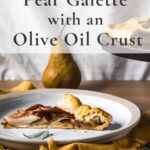
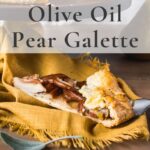

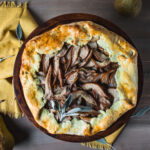
Your recipe gave me the idea of using some lemon flavored olive oil I have. I’ll let you know how my plum galette turns out!
~ Kathleen